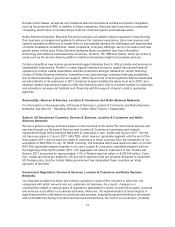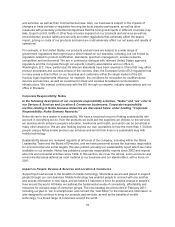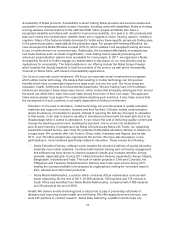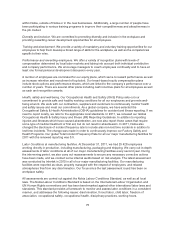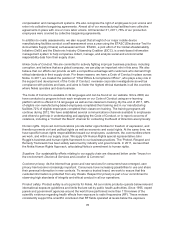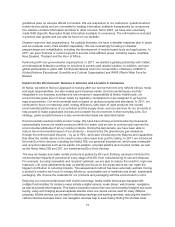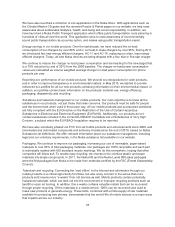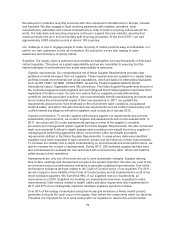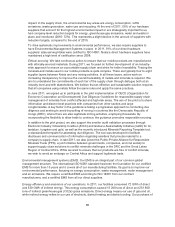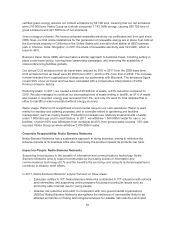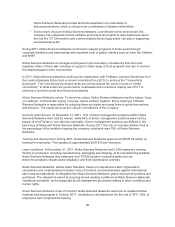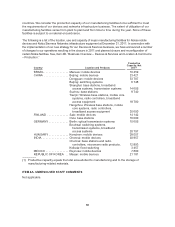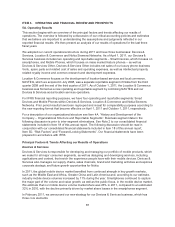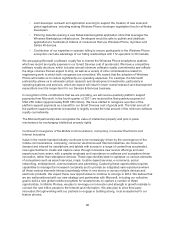Nokia 2011 Annual Report Download - page 82
Download and view the complete annual report
Please find page 82 of the 2011 Nokia annual report below. You can navigate through the pages in the report by either clicking on the pages listed below, or by using the keyword search tool below to find specific information within the annual report.impact. In the supply chain, the environmental key areas are energy consumption, GHG
emissions, waste generation, water use and recycling. At the end of 2011, 66% of our hardware
suppliers that account for the highest environmental impact or are strategically important to us,
had company-level reduction targets for energy, greenhouse gas emissions, water and waste in
place and monitored (2010: 72%). This represents a slight decline in the amount of suppliers with
reduction targets, compared to the end of 2010.
To drive systematic improvements in environmental performance, we also require suppliers to
have Environmental Management Systems in place. In 2011, 91% of our direct hardware
suppliers’ sites serving Nokia were certified to ISO14001. Nokia’s direct hardware suppliers have
maintained a high level of certification since 2008.
Ethical sourcing. We take continuous action to ensure that our mobile products are manufactured
with ethically-sourced materials. During 2011, we focused on further development of an industry-
wide approach to ensure an accountable supply chain and strive for better traceability. Tracing the
minerals and metals used in our mobile products is quite complex. There are typically four to eight
supplier layers between Nokia and any mining activities. In all these layers, active work on
increasing transparency to improve the overall traceability of metals and minerals is required. We
aim to understand the commitments of each tier of the supply chain through dialogue both at an
industry level and with stakeholders. We believe that an effective and sustainable solution requires
that all companies using metals follow the same rules and apply the same practices.
In June 2011, we signed up to participate in the pilot implementation of OECD (Organization for
Economic Cooperation and Development) Due Diligence Guidelines for responsible supply chain
management of minerals from conflict affected and high-risk areas. The aim of the pilot is to share
information and discern best practices with companies from other sectors and large
conglomerates. A key factor in the guidance is taking a progressive approach to conducting due
diligence and seeking to avoid boycotting of mining in countries like the Democratic Republic of
Congo (DRC), where there are also legitimate mining activities, employing thousands. By
incorporating the flexibility to allow trade to continue, the guidance promotes responsible sourcing.
In addition to the pilot project, we also support the smelter audit validation processes through
Electronic Industry Citizenship Coalition (EICC) and Global e-Sustainability Initiative (GeSI) for tin,
tantalum, tungsten and gold, as well as the recently introduced Minerals Reporting Template tool,
a standardized template for assessing due diligence. The tool was developed to facilitate
disclosure and communication of information regarding smelters that provide material to a
company’s supply chain. In late 2011, we also joined the Public-Private Alliance for Responsible
Minerals Trade (PPA), a joint initiative between governments, companies, and civil society to
support supply chain solutions to conflict minerals challenges in the DRC and the Great Lakes
Region of Central Africa. While we want to ensure that our products are free of conflict minerals,
we wish to avoid an embargo on Central Africa and support legitimate trade.
Environmental management systems (EMS). Our EMS is an integral part of our common global
management structure. The international ISO14001 standard has been the foundation for our certified
EMS for more than 15 years and it covers all of our manufacturing facilities. Its goal is to improve our
environmental performance, focusing on energy consumption, waste management, water management
and air emissions. We require a certified EMS according to ISO 14001 from our contract
manufacturers, and a certified EMS from all our direct suppliers.
Energy efficiency and emissions of our operations. In 2011, our facilities consumed 72 GWh of direct
and 530 GWh of indirect energy. This energy consumption caused 13 200 tons of direct and 251 800
tons of indirect greenhouse gas (CO2e) gross emissions. Direct energy means our use of gas and oil,
while indirect energy refers to our use of electricity, district heating and district cooling. Our purchase of
80



